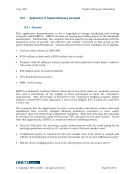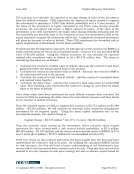June 2007 Capital Adequacy Extension © Copyright 2007, CCRO. All rights reserved. Page 45 of 92 translated into policies and procedures within that company. A major aspect to the independent reviews is the validation of the risk estimates. As part of the validation process, key assumptions used in the risk assessment must undergo a critical review. Also, reasonableness checks should be conducted through a comparison of expected vs. realized operational loss events, as part of a back-testing analysis. A thorough end-to-end independent audit of the operational risk assessment program will provide great value and ensure that capital adequacy assessed for operational risks remains valid. 4.11. Role of Disclosure PRINCIPLE 10: [Companies] should make sufficient public disclosure to allow market participants to assess their operational risk exposure and the quality of their operational risk management. As discussed, ensure that the actions taken and the measurements used can be clearly understood by external constituents. The metrics around operative risks are the least agreed upon and there is no VaR or unexpected loss equivalent in the area of operative risk. Therefore, transparency is of the utmost importance in dealing with operative risks because the unique nature of these risks and the confusion that surrounds them. Investors, analysts, rating agencies, and regulatory authorities are all parties that should be able to comprehend what was done and why it was done. From a qualitative perspective, disclosure should include a detailed description of the Operational Risk Assessment and Capital Allocation process that includes14: • The Strategy and Process • The Structure and Organization of the Operational Risk Management Function • The Scope and Nature of Risk Reporting and/or Measurement Systems • Policies for Mitigating risk and Strategies and Processes for monitoring the continuing effectiveness of mitigants From a quantitative perspective, operational risk capital assessed to each of the business units should be made available, with an explanation as to how those numbers were determined. Ultimately, if any information’s misstatement or omission would change or influence the decision of a reasonable investor relying on that information, then that information should be a part of the disclosure.15 14 Working Paper on Pillar 3 – Market Discipline. Basel Committee on Banking Supervision. September 2001. 15 Ibid
Purchased by unknown, nofirst nolast From: CCRO Library (library.ccro.org)




























































































